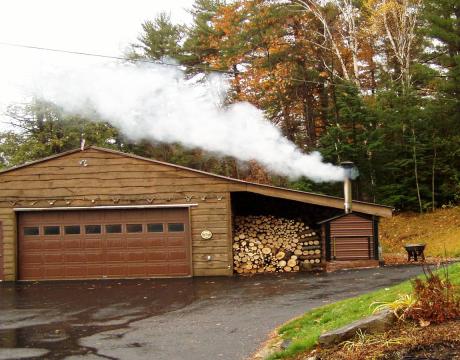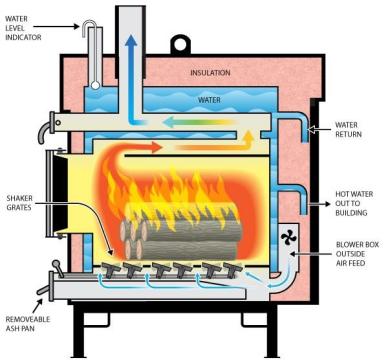Air: Outdoor Wood Boilers
Outdoor wood boilers (OWBs), or water stoves, can be a cost-effective way to heat homes in Wisconsin's cooler months. However, smoke from burning wood in OWBs makes a type of air pollution, called fine particles or particulate matter 2.5, that harms people's health. Breathing in fine particles are especially hard on people with heart and lung diseases like asthma.
When OWBs are placed and operated correctly, they can be a safer source of heat and hot water. Plus, 30% federal tax credits are available from 2023-2032 to offset the cost of purchasing a new, certified OWB. The design of the certified OWBs decrease the amount of smoke from wood burning.
In Wisconsin, local health departments have the authority to address health concerns related to OWBs under Wis. Stat. ch. 254. Learn more below about practices that reduce harmful smoke from OWBs so everyone can breathe easier.
An OWB is a furnace, stove, or boiler designed to burn wood for heat. It's placed outside of the structure that’s being heated. Also known as water stoves, OWBs look like a small utility building with a smokestack.
OWBs provide heat and/or hot water to a home. Their design includes a firebox enclosed in a water jacket, surrounded by insulation, and vented through a chimney stack. The combustion of wood heats the water in a reservoir, then the heated water is carried through underground pipes to heat homes, outbuildings, pools, and hot tubs.
OWBs are more popular in rural areas with an abundant source of wood nearby. They cost between $3,000 and $10,000. The Environmental Protection Agency (EPA) now requires people to purchase EPA-certified OWBs that are significantly cleaner, improving air quality and reducing health harms in communities where people burn wood for heat and hot water.
Illustration of how an OWB warms a house
OWB cross-section
Wood smoke contains a mix of at least 100 different harmful chemicals in the form of water, organic vapors, gases, and tiny particles. The chemicals in wood smoke can cause air quality and health problems. Four of the chemical compounds in wood smoke are on EPA’s list of six serious “criteria pollutants” in the National Ambient Air Quality Standards, including:
- Carbon monoxide.
- Nitrogen oxides.
- Particulate matter.
- Sulfur dioxide.
Wood smoke and creosote buildup from OWBs can also cause unhealthy levels of toxic air pollutants. Some of the pollutants are known to cause cancer, including:
- Acrolein.
- Benzene.
- Formaldehyde.
- Polycyclic aromatic hydrocarbons.
When you breathe in particle pollution from wood smoke, it can cause heart and lung problems. The tiny particles can lodge deep inside your lungs and even get into your bloodstream. Particulate matter is so tiny, it has the ability to get into homes through cracks even when windows and doors are closed.
Health impacts and symptoms from wood smoke exposure include:
- Eye, nose and throat irritation.
- Fatigue.
- Headaches.
- Nausea.
- Coughing.
- Difficult or rapid breathing.
- Aggravated asthma, emphysema, bronchitis, and other lung diseases.
- Damaged lungs in children.
- Increased risk of respiratory illnesses like pneumonia or bronchitis.
- Chest pain and tightness.
- Confusion.
- Decreased alertness.
- Impaired judgement.
- Increased risk of heart attack, irregular heartbeat, heart failure, and stroke.
- Aggravated angina and other heart diseases.
- Cancers.
- Premature death.
Who’s at risk?
Exposure to wood smoke can affect everyone, but it harms some people more than others. It can be particularly harmful to:
- Babies, children, and teens.
- Older adults.
- Pregnant people.
- People with heart or lung diseases.
People with heart and lung diseases are especially sensitive to wood smoke exposure, including those with:
- Asthma.
- COPD (chronic obstructive pulmonary disease).
- Emphysema.
- Heart disease.
People’s health risks from wood smoke exposure depend on the amount of wood smoke and how long they’re exposed. Because most OWBs have short stacks and are located close to homes, people living near them, including neighbors, are at a greater risk of health harms.
Health risks from burning non-wood materials
Burning certain materials can release highly toxic chemicals. Never burn the following materials in OWBs:
- Particleboard.
- Wood that is treated, stained, painted.
- Freshly cut or wet wood.
- Trash.
Burning trash also is harmful because it releases chemicals that pollute the air, soil, food, lakes, and streams.
Burning plastic and treated wood also release heavy metals and toxic chemicals such as dioxins. Dioxins can cause skin conditions, reproductive or developmental problems, and increased cancer risks.
Although the EPA has regulations for reducing pollution from residential stoves and fireplace inserts, there are currently no federal or state standards regulating their use. The only exception is EPA’s 2015 requirements for manufacturing and purchasing cleaner-burning OWBs. As a result, regulations at the local level are the best way to address public health concerns. Several Wisconsin communities have taken steps to create ordinances that ban or regulate the use of OWBs.
The EPA hosts a Burn Wise webpage with links to state and local agencies that work to reduce emissions from OWBs. The webpage also includes current OWB regulations.
In addition, the Wisconsin Department of Health Services (DHS) compiled a List of Local Ordinances Regulating Outdoor Wood Boilers and Residential Wood Smoke (PDF), though it’s not a complete nor up-to-date list. Instead, local communities should use it as a starting point when considering enacting their own ordinances.
Finally, the Wisconsin Department of Natural Resources (DNR) developed a guidance document and model ordinance for local communities interested in regulating OWBs and wood smoke to protect public health.
In some communities, the best approach to managing nuisance complaints and public health dangers is a local ordinance that restricts or bans the use of OWBs. Although OWBs are typically used in rural settings, an increasing number are being installed in subdivisions and small towns.
If your local government receives complaints about OWBs, consider the following best practices for managing their placement and use:
- Ensure that OWBs are installed where they don’t create a health hazard from wood smoke. Local officials should carefully consider zoning controls when changing land use is incompatible with OWBs. This is especially important when agricultural-zoned land is changed to residential. This change frequently results in homes being built too close to OWBs.
- Limit what can be burned in an OWB to clean, dry firewood.
- Place OWBs at least 300 to 500 feet from the nearest building on neighboring properties.
- Require an OWB chimney height of 15 feet or higher than the roofs of nearby buildings.
- Require annual permitting of OWBs by the local fire chief.
For more guidance, use the DNR’s guidance document and model ordinance for local communities interested in regulating OWBs and wood smoke.
For more information, contact us at 608-266-1120 or by our mailing address:
Wisconsin Department of Health Services
Division of Public Health, Bureau of Environmental and Occupational Health (DPH/BEOH)
201 E. Washington Ave.
Madison, WI 53703
You also can refer to these helpful resources:
- DHS List of Local Ordinances Regulating Outdoor Wood Boilers and Residential Wood Smoke (PDF)
- EPA National Ambient Air Quality Standards
- DNR Open Burning webpage
- DHS Trash and Wood Burning webpage
- State of Washington Department of Ecology Smoke Health Effects and Burning Alternatives webpage
Five tips to safely operate an OWB
Follow these tips to keep the air clean when using an outdoor wood boiler:
- Use an EPA-certified, cleaner burning OWB.
- Only burn dry (less than 20% moisture), untreated wood.
- Provide sufficient air to the fire–never let it smolder.
- Close your windows and doors to keep smoke out of your home.
- Make sure your chimney is at least 15 feet high, or higher than any nearby structures.
Source: University of Wisconsin-Madison




